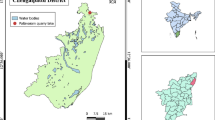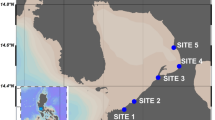Abstract
The environmental impact of major oil spills on marine microorganisms has yet to be thoroughly investigated using molecular biology techniques. The Deepwater Horizon (DWH) drilling rig explosion of 2010 affected an approximately 176,000 km2 surface area of the Gulf of Mexico (GOM) when an estimated 210 million gallons of oil from the Macondo Prospect spilled into the environment. Pelagic Sargassum, a complex of two surface drifting species (Sargassum natans and Sargassum fluitans) of marine brown macroalgae and a critically important habitat in the GOM ecosystem, was suffused by Macondo Prospect 252 oil released during the DWH event. Using 16S rRNA PCR and Roche 454 pyrosequencing, the effect of the oil on the bacterial population associated with pelagic Sargassum and contiguous waters was examined by comparing sequence data generated from samples collected from oiled and non-oiled locations in the northern GOM. Sequence data showed similar microbial composition in Sargassum regardless of exposure to oil primarily dominated by five phyla; Proteobacteria, Bacteroidetes, Actinobacteria, Verrucomicrobia, and unclassified bacteria. The microbial composition in water samples was significantly less diverse than for Sargassum and consisted primarily of Proteobacteria, Firmicutes, and Bacteroidetes. Due to the evenly distributed abundance of microbial species on oiled and non-oiled pelagic Sargassum, study findings indicate that DWH spilled oil had minimal effect on the composition and diversity of the microbial community associated with Sargassum and contiguous waters. However, higher abundances of Sulfitobacter and one species of Psychrobacter were found in oiled water samples when compared to non-oiled water samples indicating some effect of DHW oil in the microbial composition of seawater. Though there are a number of marine studies using molecular biology approaches, this is the first molecular examination of the impact of the DWH oil spill on bacterial communities associated with pelagic Sargassum and contiguous waters from the GOM.








Similar content being viewed by others
References
Blunt JW, Copp BR, Keyzers RA, Munro MH, Prinsep MR (2016) Marine natural products. Nat Prod Rep 33(3):382–431. doi:10.1039/c5np00156k
de Jesus Raposo MF, de Morais AM, and de Morais RM (2016) Emergent sources of prebiotics: seaweeds and microalgae. Mar Drugs 14(2). pii: E27. doi:10.3390/md14020027.
de Jesus Raposo MF, de Morais AM, de Morais RM (2015) Marine polysaccharides from algae with potential biomedical applications. Mar Drugs 13(5):2967–3028. doi:10.3390/md13052967
Yende SR, Harle UN, Chaugule BB (2014) Therapeutic potential and health benefits of Sargassum species. Pharmacognosy Rev 8(15):1–7
Schiel DR, Foster MS (2006) The population biology of large brown seaweeds: ecological consequences of multiphase life histories in dynamic coastal environments. Annu Rev Ecol Evol Syst 37(1):343–372
van den Hoek C, Mann DG, and Jahns HM (1996) Algae: an introduction to phycology. Cambridge University Press
South Atlantic Fishery Management Council (2002) Fishery management plan for pelagic Sargassum habitat of the South Atlantic region. p. 1-153.
Hazen TC et al (2010) Deep-sea oil plume enriches indigenous oil-degrading bacteria. Science 330(6001):204–208
Carr A (1987) New perspectives on the pelagic stage of sea turtle development. Conserv Biol 1(2):103–121
Carpenter EJ, Cox JL (1974) Production of pelagic Sargassum and a blue-green epiphyte in the western Sargasso Sea. Limnol Oceanogr 19(3):429–436
Phlips EJ, Zeman C (1990) Photosynthesis, growth and nitrogen fixation by epiphytic forms of filamentous cyanobacteria from pelagic Sargassum. Bull Mar Sci 47(3):613–621
Powers SP et al (2013) Novel pathways for injury from offshore oil spills: direct, sublethal and indirect effects of the Deepwater Horizon oil spill on pelagic Sargassum communities. PLoS One 8(9):e74802
Dooley JK (1972) Fishes associated with the pelagic Sargassum complex, with a discussion of the Sargassum community. Contrib Mar Sci 16:1–32
Wells RJD, Rooker JR (2004) Spatial and temporal patterns of habitat use by fishes associated with < i > Sargassum</i > mats in the northwestern Gulf of Mexico. Bull Mar Sci 74(1):81–99
Hoffmayer ER et al (2005) Larval and juvenile fishes associated with pelagic Sargassum in the northcentral Gulf of Mexico. Proc Gulf Caribb Fisheries Inst 56:259–270
Casazza TL, Ross SW (2008) Fishes associated with pelagic Sargassum and open water lacking Sargassum in the Gulf Stream off North Carolina. Fish Bull 106(4):348–363
Singh RP, Reddy CR (2014) Seaweed-microbial interactions: key functions of seaweed-associated bacteria. FEMS Microbiol Ecol 88(2):213–30
Martin M et al (2015) The cultivable surface microbiota of the brown alga Ascophyllum nodosum is enriched in macroalgal-polysaccharide-degrading bacteria. Front Microbiol 6:1487
Hester ER et al. (2016) Stable and sporadic symbiotic communities of coral and algal holobionts. ISME J 10: 1157–1169
Zozaya-Valdes E, Egan S, Thomas T (2015) A comprehensive analysis of the microbial communities of healthy and diseased marine macroalgae and the detection of known and potential bacterial pathogens. Front Microbiol 6:146. doi:10.3389/fmicb.2015.00146
Hollants J et al (2013) What we can learn from sushi: a review on seaweed-bacterial associations. FEMS Microbiol Ecol 83(1):1–16
Egan S et al (2013) The seaweed holobiont: understanding seaweed-bacteria interactions. FEMS Microbiol Rev 37(3):462–76
National Oceanic Atmospheric Administration (2015) About the Deepwater Horizon oil spill. Available from: http://www.gulfspillrestoration.noaa.gov/oil-spill/.
Zunkunft PF (2010) Summary report for sub-sea and sub-surface oil and disperion detection: sampling and monitoring. Available from: http://www.restorethegulf.gov/sites/default/files/documents/pdf/OSAT_Report_FINAL_17DEC.pdf.
Norse EA, Amos J (2010) Impacts, perception, and policy implications of the BP/Deepwater Horizon oil and gas disaster. Environ Law Report 40(11):11058–11073
Roffer MA (2015) Roffer’s Ocean Fishing Forecasting Service Inc. [cited 2015 21 September]; Available from: http://www.roffs.com/
Edwards U et al (1989) Isolation and direct complete nucleotide determination of entire genes. Characterization of a gene coding for 16S ribosomal RNA. Nucleic Acids Res 17(19):7843–53
Muyzer G, de Waal EC, Uitterlinden AG (1993) Profiling of complex microbial populations by denaturing gradient gel electrophoresis analysis of polymerase chain reaction-amplified genes coding for 16S rRNA. Appl Environ Microbiol 59(3):695–700
Liu Z et al (2008) Accurate taxonomy assignments from 16S rRNA sequences produced by highly parallel pyrosequencers. Nucleic Acids Res 36(18):e120
Kumar PS et al (2011) Target region selection is a critical determinant of community fingerprints generated by 16S pyrosequencing. PLoS One 6(6):e20956
Schloss PD et al (2009) Introducing mothur: open-source, platform-independent, community-supported software for describing and comparing microbial communities. Appl Environ Microbiol 75(23):7537–41
Pruesse E et al (2007) SILVA: a comprehensive online resource for quality checked and aligned ribosomal RNA sequence data compatible with ARB. Nucleic Acids Res 35(21):7188–7196
Paradis E, Claude J, Strimmer K (2004) APE: analyses of phylogenetics and evolution in R language. Bioinformatics 20(2):289–290
Jari Oksanen FGB, Roeland K, Pierre L, Peter RM, O’Hara RB, Simpson GL, Solymos P, Stevens MHH and Wagner H (2015) vegan: community ecology package. R package version 2.3-0. [cited 2016; R package version 2.3-0]. Available from: http://CRAN.R-project.org/package=vegan
Kostka JE et al (2011) Hydrocarbon-degrading bacteria and the bacterial community response in Gulf of Mexico beach sands impacted by the Deepwater Horizon oil spill. Appl Environ Microbiol 77(22):7962–74
Yakimov MM, Timmis KN, Golyshin PN (2007) Obligate oil-degrading marine bacteria. Curr Opin Biotechnol 18(3):257–66
Administration, N.O.A. (2015) National Environmental Satellite, Data, and Information Service. [cited 2015 21 September]; Available from: http://www.nesdis.noaa.gov/index.html
Brakstad OG, Lodeng AG (2005) Microbial diversity during biodegradation of crude oil in seawater from the North Sea. Microb Ecol 49(1):94–103
Buchan A et al (2014) Master recyclers: features and functions of bacteria associated with phytoplankton blooms. Nat Rev Micro 12(10):686–698
McIlroy S. and Nielsen P 2014 The Family Saprospiraceae, in The Prokaryotes, Rosenberg E et al, Editors. Springer Berlin Heidelberg. p. 863-889
Lapointe BE et al (2014) Ryther revisited: nutrient excretions by fishes enhance productivity of pelagic Sargassum in the western North Atlantic Ocean. J Exp Mar Biol Ecol 458:46–56
Lee SY et al (2012) Salinimicrobium gaetbulicola sp. nov., isolated from tidal flat sediment. Int J Syst Evol Microbiol 62(Pt 5):1027–31
Nedashkovskaya OI et al (2010) Salinimicrobium marinum sp. nov., a halophilic bacterium of the family Flavobacteriaceae, and emended descriptions of the genus Salinimicrobium and Salinimicrobium catena. Int J Syst Evol Microbiol 60(Pt 10):2303–6
Bozal N et al (2003) Characterization of several Psychrobacter strains isolated from Antarctic environments and description of Psychrobacter luti sp. nov. and Psychrobacter fozii sp. nov. Int J Syst Evol Microbiol 53(Pt 4):1093–100
Valentine DL et al (2010) Propane respiration jump-starts microbial response to a deep oil spill. Science 330(6001):208–211
Kodama Y et al (2008) Thalassospira tepidiphila sp. nov., a polycyclic aromatic hydrocarbon-degrading bacterium isolated from seawater. Int J Syst Evol Microbiol 58(Pt 3):711–5
Brakstad OG et al (2015) Microbial communities related to biodegradation of dispersed Macondo oil at low seawater temperature with Norwegian coastal seawater. Microb Biotechnol 8(6):989–98
Brakstad OG, Nordtug T, Throne-Holst M (2015) Biodegradation of dispersed Macondo oil in seawater at low temperature and different oil droplet sizes. Mar Pollut Bull 93(1-2):144–52
Chronopoulou PM et al (2015) Generalist hydrocarbon-degrading bacterial communities in the oil-polluted water column of the North Sea. Microb Biotechnol 8(3):434–47
Acknowledgments
The authors extend their sincere appreciation to the Guy Harvey Ocean Foundation for supporting critical aspects of this research. We acknowledge NOAA Fisheries, Southeast Fisheries Science Center, and SEAMAP for providing funding in support of the ichthyoplankton survey cruise. This study was partially supported by the Gulf of Mexico Research Initiative administered by the Northern Gulf Institute, Mississippi State University, and by the J. Craig Venter Institute. We express our gratitude to the captains and the crew of the R/V Tommy Munro and to Marcia Pendleton for the assistance in sample collection. We thank Tracy Berutti for performing the DNA extractions. We express our appreciation to Mitch Roffer, Greg Gawlikowski, and Matthew Upton (Roffer’s Ocean Fishing Forecasting Service, Inc.; http://www.roffs.com) for providing satellite imagery/analysis and invaluable advice to assist us in the selection of collection stations. Jason Tilly assisted in developing Fig. 3. We thank Ben Raines for the use of his underwater photograph of fishes associated with pelagic Sargassum.
Author information
Authors and Affiliations
Corresponding author
Ethics declarations
Conflict of Interest
The authors declare no conflict of interest.
Rights and permissions
About this article
Cite this article
Torralba, M.G., Franks, J.S., Gomez, A. et al. Effect of Macondo Prospect 252 Oil on Microbiota Associated with Pelagic Sargassum in the Northern Gulf of Mexico. Microb Ecol 73, 91–100 (2017). https://doi.org/10.1007/s00248-016-0857-y
Received:
Accepted:
Published:
Issue Date:
DOI: https://doi.org/10.1007/s00248-016-0857-y




